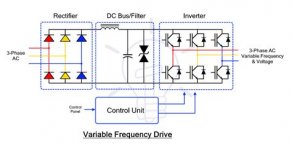powerplay
Senior Member
- Location
- In front of a computer.
Hello,
I was enquiring about connecting a single phase
240 volt 60 amp rated VFD locked at 60 hz to provide three phase 240 volt for a 30 amp 5 hp rated CNC Machine control panel.
I was told only a Rotophase with voltage control will work properly and a VFD needs to be directly connected to the motor and will not work.
If the VFD is locked so as not to vary, is there an issue having it in series with the CNC Machine ?
Thanks for any feedback !!
I was enquiring about connecting a single phase
240 volt 60 amp rated VFD locked at 60 hz to provide three phase 240 volt for a 30 amp 5 hp rated CNC Machine control panel.
I was told only a Rotophase with voltage control will work properly and a VFD needs to be directly connected to the motor and will not work.
If the VFD is locked so as not to vary, is there an issue having it in series with the CNC Machine ?
Thanks for any feedback !!


